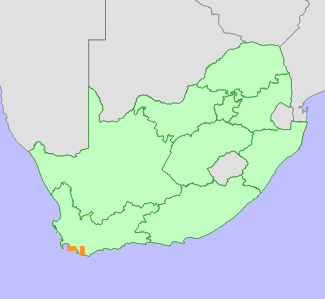|
Scientific Name | Pterygodium bifidum (Sond.) Schltr. |
Higher Classification | Monocotyledons |
Family | ORCHIDACEAE |
Synonyms | Corycium bifidum Sond., Corycium ligulatum Rchb.f. |
National Status |
Status and Criteria | Critically Endangered C2a(i); D |
Assessment Date | 2015/10/01 |
Assessor(s) | L. von Staden, C.A. Pauw, W.R. Liltved, E.G.H. Oliver & T.A. Oliver |
Justification | An extremely rare species, known from three subpopulations, the largest consisting of only 30 mature individuals, and the known population numbering less than 50 mature individuals. It is declining due to ongoing habitat loss, fragmentation and degradation. |
Distribution |
Endemism | South African endemic |
Provincial distribution | Western Cape |
Range | Kogelberg to Pearly Beach. |
Habitat and Ecology |
Major system | Terrestrial |
Major habitats | Overberg Sandstone Fynbos, Kogelberg Sandstone Fynbos |
Description | South-facing slopes and ridge summits in fynbos, and well-drained Table Mountain Sandstone derived sand near limestone outcrops, 0-450 m. |
Threats |
| Like most lowland Cape species, this species has probably declined due to habitat destruction in the past. It is hard to quantify the extent of the decline, as this species is extremely rare and only flowers sporadically after fires. It is threatened by ongoing habitat loss and fragmentation due to coastal development and agricultural expansion, and much of its remaining habitat is densely infested with alien invasive plants. Fire suppression due to habitat fragmentation is a major concern. Extinction of specialist pollinators from fragmented areas is a potential threat to this species, as it has limited capacity for clonal reproduction (A Pauw, pers. comm.). |
Population |
This extremely rare orchid has been observed only a few times, and is currently known from three small subpopulations observed within the past 10 years. The largest consists of about 30 mature individuals, while the other two have only about 10 each. It is dependent on fire to flower, and dormant subpopulations may therefore be easily overlooked. Fire suppression due to ongoing habitat fragmentation however means that subpopulations will fail to flower, and may eventually disappear even in intact vegetation.
|
Population trend | Decreasing |
Notes |
| There is ongoing scientific debate regarding the placement of this taxon, with some publications (e.g. Johnson and Bytebier 2015) classifying it in the genus Corycium, while others, such as Manning and Goldblatt (2012) include it within Pterygodium. |
Assessment History |
Taxon assessed |
Status and Criteria |
Citation/Red List version | | Pterygodium bifidum (Sond.) Schltr. | CR C2a(i); D | 2014.1 | | Corycium bifidum Sond. | CR C2a(i); D | Raimondo et al. (2009) | | Corycium bifidum Sond. | Data Deficient | Victor (2002) | | Corycium bifidum Sond. | Endangered | Hilton-Taylor (1996) | | Corycium bifidum Sond. | Indeterminate | Hall et al. (1980) | |
Bibliography |
Goldblatt, P. and Manning, J.C. 2000. Cape Plants: A conspectus of the Cape Flora of South Africa. Strelitzia 9. National Botanical Institute, Cape Town.
Hall, A.V., De Winter, M., De Winter, B. and Van Oosterhout, S.A.M. 1980. Threatened plants of southern Africa. South African National Scienctific Programmes Report 45. CSIR, Pretoria.
Hilton-Taylor, C. 1996. Red data list of southern African plants. Strelitzia 4. South African National Botanical Institute, Pretoria.
Johnson, S. and Bytebier, B. 2015. Orchids of South Africa: A field guide. Struik Nature, Cape Town.
Liltved, W.R. and Johnson, S.D. Unpublished. The Cape Orchids - Wild orchids of the Cape Floral Kingdom.
Linder, H.P. 1999. Corycium. In: H.P. Linder and H. Kurzweil (eds.), Orchids of southern Africa (pp. 339-350), A.A. Balkema, Rotterdam.
Manning, J.C. and Goldblatt, P. 2012. Plants of the Greater Cape Floristic Region 1: The Core Cape Flora. Strelitzia 29. South African National Biodiversity Institute, Pretoria.
Raimondo, D., von Staden, L., Foden, W., Victor, J.E., Helme, N.A., Turner, R.C., Kamundi, D.A. and Manyama, P.A. 2009. Red List of South African Plants. Strelitzia 25. South African National Biodiversity Institute, Pretoria.
Victor, J.E. 2002. South Africa. In: J.S. Golding (ed), Southern African plant Red Data Lists. Southern African Botanical Diversity Network Report 14 (pp. 93-120), SABONET, Pretoria.
|
Citation |
| von Staden, L., Pauw, C.A., Liltved, W.R., Oliver, E.G.H. & Oliver, T.A. 2015. Pterygodium bifidum (Sond.) Schltr. National Assessment: Red List of South African Plants version 2024.1. Accessed on 2025/12/23 |
 Comment on this assessment
Comment on this assessment


